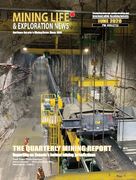For IAMGOLD Bigger is not always better
Work on re-designed Cote Lake Gold Project set to begin next January
Steve Woolfenden IAMGOLD’s VP of Operations gave a promising update in Timmins yesterday to its Cȏté Lake Gold Mine Project just off Highway 144 north of Gogama and the Mattagami First Nation.
It was the first of three open houses in the area with additional open houses held in Sudbury (Feb. 14) and Gogama (Feb.15)
Woolfenden told the Timmins open house construction will begin in January 2019 and bring an estimated 1,000 jobs during the construction phase. An additional 400 to 500 jobs permanent jobs will be created when the mine is fully operational in 2021.
Jobs
“The communities near our site will benefit with the creation of jobs during the construction phase from 2019 to 2020 and approximately 400 jobs during our operational period,” Woolfenden said. “That includes the Mattagami First Nations (a few km north of Gogama), Gogama (20 km southwest), Timmins (130 km north) and Sudbury (200 km south).
The Flying Post First Nation will also benefit from the project and has been part of the negotiations and consultation process.
Smaller Foot Print
Redesign of the project also will bring a smaller foot print to bear on the project explained Woolfenden.
“Since we were last in Timmins, in 2015 we have received approval under the Canadian Environmental Assessment Act and the Ontario Environmental Assessment Act,” said Woolfenden.
“We listened to the recommendations of local communities and First Nations nearby to redesign our original project,” Woolfenden explained.
“Bigger is not always better,” Woolfenden said. “Our new proposal is much smaller and will leave a smaller footprint.
The gold will still be mined as an open pit mine, but it will smaller and located about 2 km south of the original proposal.
The operational life has been extended to 17 years from 15 years based on the slower pace of ore extraction. In the first plan, extraction was rated at approximately 60,000 tonnes per day. The revised plan has halved that to about 30,000 tonnes.
The mill size has been reduced as a result.
http://www.iamgold.com/English/home/default.aspx
The major Project components are expected to include:
- an open pit and an ore processing plant;
- a maintenance garage, warehouse and administration complex;
- operations accommodations complex;
- an explosives manufacturing and storage facility;
- various stockpiles of low-grade ore, overburden and mine rock;
- aggregate extraction with crushing and screening plants;
- a tailings management facility ;
- on-site roads and pipelines, power infrastructure and fuel storage facilities;
- potable and process water treatment facilities;
- a solid and industrial landfill;
- water management facilities and drainage work, including watercourse realignments;
- a transmission line.
Location
IAMGOLD on their website describes the land as gentle hills, forests, lakes and rivers. It is located on two subwatersheds, the Mollie River system and the Mesomikenda River system. The continental watershed divide is located about 3.5 km south from the proposed open pit location.
The nearby area is used for fishing, camping and hunting. Sustainable logging also takes place.
History
IAMGOLD acquired the site in 2012 from Trelawney Mining and Exploration Inc. when the price of Gold was close to US $1800 per ounce. Trelawney had conducted diamond drilling activities in 2010 to delineate the gold deposit.
The area has been explored since the early 1900s, and the early 1940s, 1970s to 1990.
In 2015 IAMGOLD announced it was suspending Cȏté Lake as the price of gold teetered towards US $1000 US.
However, the price of gold has risen to US $1,350 per oz. and the project is viable again
Benefits of Project Redesign
The redesigned project will consist of two smaller phases, in an area slightly to the southwest of the original site. The partial removal of Cȏté Lake to get to the ore has been addressed, by agreeing to create a new lake once operations close and are remediated.
The concerns of Mattagami First Nation and Flying Post First nation about the loss of traditional hunting ground were addressed in the redesign and there will be greater protection of First Nation hunting areas as a result.

|